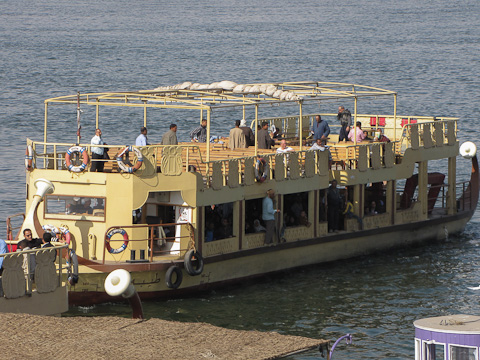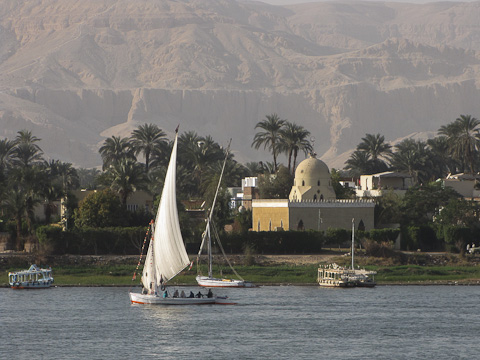Getting Around
The easiest and the quickest, though most expensive way to travel around Egypt is by domestic air travel. Egyptair offer a range of daily flights between the larger cities.

From Cairo you can get an airport bus which makes several stops between the airport and the Pyramids Road in Giza. Alternatively there are always lots of taxis waiting at the airport to take visitors to their hotels and the same applies to Luxor, Aswan and other airports.
The whole of the Nile Valley from Alexandria to Aswan is covered by a rail service run by the Egyptian government, but when trying to book a ticket on these trains visitors are often told that they are only allowed to travel on the ‘tourist train’. This is a sleeper train which runs daily from Cairo to Aswan operated by a private company, Wagon Lits and is superbly comfortable even without a sleeper compartment. It is advisable to book tickets at least a day in advance. Otherwise, if you are prepared for an argument at the ticket office, you can travel on any of the frequent government trains which are less expensive and less comfortable.

Air-conditioned coaches operate throughout Egypt and are generally inexpensive with two coaches a day between Cairo and Aswan, but be prepared for a long journey. There are also local buses without air-conditioning between all Egyptian towns. Check the main bus terminals for details of times and costs. It often costs only a little more to travel in the more comfortable coaches.
Cairo
In Cairo and Alexandria there are metro routes covering many parts of the cities. This is an easy, exceptionally clean and inexpensive way to travel around and the underground trains run at very frequent intervals all day. A single journey on the Cairo metro costs 50 piastres (EGP 0.50). The entrance to underground stations can be recognised by a circular sign with an ‘M’ in the centre. In Cairo the metro system is currently being extended. There are usually separate coaches at the front of the trains for women and I would recommend their use by women travelling alone. They are usually much less crowded than the rest of the train and you will not be hassled or treated as an object of curiosity.
There are two types of buses in Cairo. Large overcrowded buses travel routes throughout the city, often with a dozen children hanging on to the sides and you can get to most places on these routes. Smaller more comfortable buses which do not allow standing also operate the major routes. They are an inexpensive way to travel.

Taking a taxi in Cairo could be the experience of a lifetime. Hang on to your hat and be prepared for a rollercoaster journey through the city, at least when you are not stuck in a traffic jam. There is supposed to be a standard metered tariff for all journeys which is strictly enforced (EGP 5-10 for each city district covered in a journey). You can hire a taxi by the day for an agreed price, but make sure the driver knows where you want to go and how to get there and always agree a price before you set off. Taxis are available anywhere, but will always be waiting outside the big hotels. Taxis in Cairo operate by district. If you are staying outside the city centre you may find that a taxi driver will not be able to take you to the other side of the city – this is because they may only have a licence for their local district. Taxis outside the larger tourist hotels usually have an ‘all Cairo’ licence. You can also hail a ‘service taxi’ which is shared by other people who are going your way.
Luxor
Taxis are the easiest way to get around Luxor. Any journey within the town centre should cost around EGP 5 or EGP 10 from one end of town to the other, that is, from the south of town to Karnak. This is the price for the car, not for each person. As in Cairo, you can hire a car for the day by agreeing a price with the driver, which is worked out by kilometres.

In Luxor, caleches or horse-carriages operate in the same way as taxis for short journeys. This is a more leisurely way to get about and can be cool and pleasant on a warm day or evening. The prices should be the same as taxis, though the caleche drivers seem to argue more. Agree a price for your journey first. The drivers may often try to take you on a roundabout route calling at papyrus shops and bazaars at which they get commission, or they will suggest a visit to the camel market. Be warned, this is only open on a Tuesday! If you don’t want to do this be firm!
There are microbuses or ‘arabayas’ which operate on circuits around the town and this is a very inexpensive way to get around once you know the routes. Any journey in an arabaya should cost 25 piastres (EGP 0.25), but they will often charge tourists EGP 1. You can get on and off anywhere on the route, but they can get very crowded and you may have to share your seat with a basket full of live chickens. It’s good fun if you like adventures.

A passenger ferry operates from the Corniche to the West Bank all day and most of the night. These cross the Nile about every 15 minutes depending on the time of day and cost EGP 1 (for tourists) for each journey. Alternatively the owners of motor boats will constantly tout for your business and usually charge EGP 5 each for a single journey. Look out for Egyptians crossing by motor boats which operate the same way as the ferry and at the same price.

One of the attractions of Luxor (and Aswan too) are the sailing boats or ‘feluccas’ by which you can cross the Nile or take a trip by the hour. Felucca trips usually cost around EGP 20 per hour for each person but it is worth bargaining as the competition is fierce.

On the West Bank there are taxis to hire. A return trip to the Valley of the Kings should cost around EGP 40-50 per car and the driver will either wait or come back for you at an agreed time. There are arabayas here too in the form of covered Peugeot pick-up trucks which do a circuit of the West Bank but do not go to the King’s Valley. Just wave one down wherever you are and bang on the window to get off. They should cost 25 piastres for any journey, though foreigners may be asked to pay more.
You can also hire bicycles inexpensively in Luxor and on the West Bank. A good way to get around as there are no hills. There is no charge for bicycles on the ferry.
I could go on. There are donkeys, camels, horses, with boys touting for business wherever you go.
Security
Since the mid-1990s there has been a threat to tourists from terrorist activities in Egypt, but except for the Sinai coast, there have been no major incidents since 1997 and security has been stepped up drastically since then. This means that independent travel is not as quite easy as it once was. From 2009 however, the armed police convoy has ended between Aswan and Luxor and down into Middle Egypt and visitors are no longer obliged to travel all together in long lines of vehicles.

If you are intending to travel in the desert it is best to check out local advice. A four wheel drive vehicle with a supply of good spare tyres is essential and many preparations are necessary before taking a trip. Your driver will be able to organise all of these but always check that there is a plentiful supply of the obvious things such as water, food and petrol. There is a small risk of unexploded mines (left over from previous conflicts) in some desert areas, so keep to the tracks and avoid areas marked as dangerous.
Millions of tourists enjoy trouble free holidays in Egypt every year, so don’t be put off by the events of the 1990s. Travel is as easy and as safe as it possibly can be and there will always be friendly Egyptian people anxious to make your holiday a happy one.
